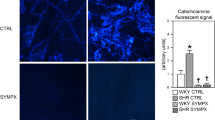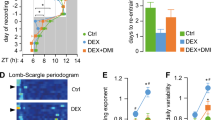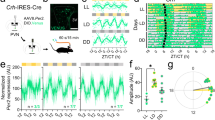Abstract
ACTIVITY of tyrosine transaminase in the rat liver1 and the concentration of corticosterone in the rodent adrenal gland2 both vary according to the time of the day. The steroid concentrations are highest around the beginning of the daily dark period, and the hepatic enzyme shows peak activity several hours later1,2. Shifts in the timing of the daily light period cause parallel changes in the phasing of both rhythms after several days3,4. Because exogenous glucocorticoids increase the activity of tyrosine transaminase in experimental animals5,6, at first it seemed likely that the enzyme cycle was generated by rhythmic changes in the plasma concentration of corticosterone. Subsequently, however, the tyrosine transaminase rhythm was shown to persist in animals the adrenal secretory rhythms of which had been extinguished by hypophysectomy or bilateral adrenalectomy1,7.
This is a preview of subscription content, access via your institution
Access options
Subscribe to this journal
Receive 51 print issues and online access
$199.00 per year
only $3.90 per issue
Buy this article
- Purchase on Springer Link
- Instant access to full article PDF
Prices may be subject to local taxes which are calculated during checkout
Similar content being viewed by others
References
Wurtman, R. J., and Axelrod, J., Proc. US Nat. Acad. Sci., 57, 1594 (1967).
Halberg, F. A., in Photoperiodism and Related Phenomena in Plants and Animals (Amer. Assoc. Advance. Sci. Publ.), 35, 803 (Washington, DC, 1959).
Wurtman, R. J., Shoemaker, W. J., Larin, F., and Zigmond, M. J., Fed. Proc., 27, 420 (1968).
Wurtman, R. J., in Neuroendocrinology (edit. by Martini, L., and Ganong, W. F.), 2, 20 (Academic Press, Inc., New York, 1967).
Lin, E. C. C., and Knox, W., Biochim. Biophys. Acta, 26, 85 (1957).
Nichol, C. A., and Rosen, F., in Actions of Hormones on Molecular Processes (edit. by Litwack, G., and Kritchevsky, D.), 234 (John Wiley, New York, 1964).
Civen, M., Ulrich, B., Trimmer, B. M., and Brown, C. B., Science, 157, 1563 (1967).
Wurtman, R. J., Shoemaker, W. J., and Larin, F., Proc. US Nat. Acad. Sci., 59, 800 (1968).
Fuller, R. W., and Snoddy, H. D., Science, 159, 738 (1968).
Wanner, W. H., Bell, J., and Munro, H. N., Biochem. J., 101, 417 (1966).
Labrie, F., and Korner, A., J. Biol. Chem., 213, 1116 (1968).
Black, I. B., and Axelrod, J., Proc. US Nat. Acad. Sci., 59, 1231 (1968).
Diamondstone, T. I., Anal. Biochem., 16, 395 (1966).
Wurtman, R. J., and Larin, F., Biochem. Pharmacol., 17, 817 (1968).
Von Euler, U. S., and Lishajko, F., Acta Physiol. Scand., 51, 348 (1961).
Glick, D., Von Redlich, D., and Levine, S., Endocrinology, 74, 653 (1964).
Author information
Authors and Affiliations
Rights and permissions
About this article
Cite this article
WURTMAN, R., SHOEMAKER, W., LARIN, F. et al. Failure of Brain Norepinephrine Depletion to extinguish the Daily Rhythm in Hepatic Tyrosine Transaminase Activity. Nature 219, 1049–1050 (1968). https://doi.org/10.1038/2191049a0
Received:
Revised:
Issue Date:
DOI: https://doi.org/10.1038/2191049a0
This article is cited by
Comments
By submitting a comment you agree to abide by our Terms and Community Guidelines. If you find something abusive or that does not comply with our terms or guidelines please flag it as inappropriate.



